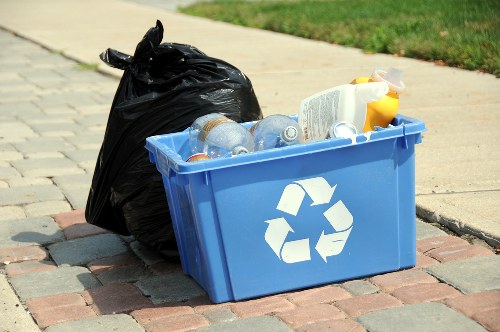Builders Waste Stamford Hill
Introduction to Builders Waste

Builders waste refers to the debris and materials leftover from construction, renovation, and demolition projects. In Stamford Hill, managing this waste efficiently is crucial for maintaining the area's cleanliness and environmental sustainability. Whether you’re a homeowner undertaking a DIY project or a professional contractor, understanding how to handle builders waste is essential.
Improper disposal of builders waste can lead to environmental pollution, legal issues, and increased costs. Stamford Hill offers various services and guidelines to help residents and businesses dispose of their builders waste responsibly. This article delves into the best practices, services available, and the importance of proper builders waste management in Stamford Hill.
By the end of this guide, you will have a comprehensive understanding of how to manage builders waste effectively, ensuring a cleaner and more sustainable Stamford Hill.
Why Proper Builders Waste Management Matters

Proper management of builders waste is not just about keeping the area tidy; it has significant environmental and economic implications. Effective waste management helps reduce landfill usage, promotes recycling, and conserves natural resources. In Stamford Hill, where community and environmental standards are highly valued, responsible waste disposal is a priority.
Moreover, complying with local regulations regarding waste disposal can help avoid hefty fines and legal issues. Stamford Hill authorities enforce strict guidelines to ensure that builders waste is disposed of in an environmentally friendly manner. Understanding and adhering to these regulations is crucial for anyone involved in construction or renovation activities.
Additionally, proper waste management can enhance the reputation of businesses and contractors, demonstrating their commitment to sustainability and community well-being.
Services for Builders Waste in Stamford Hill

Stamford Hill offers a range of services to help manage builders waste efficiently. These services cater to both small-scale projects and large construction sites, ensuring that all types of waste are handled appropriately.
1. Waste Collection Services: Local waste collection companies provide regular pickup services for builders waste. They offer flexible schedules to accommodate different project timelines.
2. Recycling Facilities: There are dedicated recycling centers in Stamford Hill where materials like concrete, wood, and metal can be processed and reused, minimizing the environmental impact.
Steps to Manage Builders Waste Effectively

Managing builders waste involves several steps to ensure that waste is disposed of responsibly and efficiently. Here are the key steps to follow:
1. Assess the Waste: Identify the types and quantities of waste generated in your project. This helps in determining the appropriate disposal method.
2. Segregate the Waste: Separate recyclable materials like metal, wood, and concrete from non-recyclable waste. Proper segregation facilitates easier recycling and reduces landfill usage.
3. Choose the Right Disposal Method: Depending on the type of waste, select an appropriate disposal method. Recycling is preferred for materials that can be reused, while hazardous waste should be handled by specialized services.
Environmental Benefits of Proper Waste Management

Proper builders waste management plays a significant role in protecting the environment. By recycling and reusing materials, we reduce the demand for new resources, thereby conserving natural habitats and reducing greenhouse gas emissions.
Additionally, responsible waste disposal prevents the contamination of soil and waterways, ensuring that Stamford Hill remains a healthy place to live and work. Sustainable practices in waste management also contribute to the broader efforts of combating climate change.
Community awareness and participation in waste management initiatives can amplify these environmental benefits, creating a collective impact that benefits everyone in Stamford Hill.
Local Regulations and Compliance
Stamford Hill has specific regulations governing builders waste to ensure that all disposal activities are eco-friendly and safe. It is essential to be aware of these regulations to avoid penalties and contribute to the community’s well-being.
Key Regulations:
- Proper segregation of waste materials.
- Use of licensed waste disposal contractors.
- Adherence to weight limits and disposal schedules.
- Prohibition of disposing hazardous materials in regular waste streams.
Staying compliant not only avoids legal issues but also promotes responsible waste management practices within the community.
Cost-Effective Waste Management Solutions
Managing builders waste does not have to be expensive. Stamford Hill offers several cost-effective solutions that cater to different budgets and project sizes.
1. Bulk Waste Collection: Many services offer bulk waste collection at competitive rates, allowing you to dispose of large quantities of waste efficiently.
2. Recycling Discounts: Some recycling centers provide discounts for materials that can be reused, lowering the overall disposal costs.
3. DIY Disposal: For smaller projects, residents can opt for DIY waste disposal using local green bins or small dumpsters, which are often more affordable.
Choosing the Right Waste Disposal Service
Selecting the right waste disposal service is crucial for efficient builders waste management. Here are some factors to consider:
- Reputation: Choose companies with a good track record and positive reviews in Stamford Hill.
- Services Offered: Ensure the service provider offers the specific waste disposal services you need, such as recycling or hazardous waste handling.
- Pricing: Compare prices to find a service that fits your budget while offering quality service.
- Availability: Opt for services that can accommodate your project's timeline and disposal schedules.
Tips for Reducing Builders Waste
Reducing builders waste not only helps the environment but also lowers disposal costs. Here are some practical tips:
- Plan Ahead: Proper planning can minimize waste by ensuring that you purchase the right amount of materials.
- Reuse Materials: Whenever possible, reuse materials from old structures in new projects.
- Optimize Cutting: Efficiently cutting materials reduces offcuts and leftover waste.
- Educate Your Team: Ensure that everyone involved in the project understands the importance of waste reduction and follows best practices.
10-15 Closest Areas to Stamford Hill
Stamford Hill is surrounded by several vibrant neighborhoods, each offering unique features and proximity benefits for builders waste management:
- East Finchley: Just southwest of Stamford Hill, East Finchley provides easy access to waste collection services and recycling centers.
- New Southgate: Located to the north, New Southgate offers various disposal facilities catering to different types of builders waste.
- Highgate: To the west, Highgate is known for its green spaces and efficient waste management systems.
- Finsbury Park: Southeast of Stamford Hill, Finsbury Park boasts large recycling facilities and waste processing plants.
- Tottenham: East of Stamford Hill, Tottenham has multiple waste disposal options suitable for both small and large projects.
- Hornsey: Northwest, Hornsey offers specialized services for hazardous builders waste.
- Crouch End: Adjacent to Stamford Hill, Crouch End provides convenient waste collection and recycling services.
- Archway: Located to the south, Archway is home to several waste management companies and recycling centers.
- Stratford: Farther east, Stratford has extensive waste disposal facilities to handle diverse builders waste.
- Upper Edmonton: North, Upper Edmonton offers accessible waste collection services for various construction projects.
- Ashbourne: West of Stamford Hill, Ashbourne provides eco-friendly waste disposal options.
- Wood Green: Nearby, Wood Green has integrated waste management systems suitable for large-scale builders waste.
- Green Lanes: Close to Stamford Hill, Green Lanes has efficient recycling centers and waste processing units.
Common Types of Builders Waste
Builders waste can vary significantly depending on the nature of the project. Here are some common types:
- Concrete and Masonry: Leftover concrete, bricks, and mortar are frequently generated in construction projects.
- Wood: Scraps from timber, plywood, and other wooden materials.
- Metal: Includes steel beams, aluminum, and other metal scraps.
- Plastics: Waste from piping, fittings, and other plastic materials.
- Glass: Broken or leftover glass from windows and fixtures.
- Drywall: Sheets of drywall and plasterboard waste.
Recycling and Reuse of Builders Waste
Recycling and reusing builders waste not only reduces the environmental impact but also helps in conserving resources. Stamford Hill promotes recycling through various programs and facilities that accept different types of builders waste.
Recycling Facilities: Local recycling centers accept materials like metal, wood, and concrete, processing them for reuse in new construction projects.
Reuse Initiatives: Initiatives encourage the reuse of materials wherever possible, reducing the need for new resources and lowering overall project costs.
By participating in these recycling and reuse programs, residents and businesses in Stamford Hill can contribute to a more sustainable community.
Challenges in Builders Waste Management
Despite the availability of services and guidelines, managing builders waste in Stamford Hill comes with its set of challenges:
- Space Constraints: Limited space for waste storage can make efficient management difficult, especially in densely populated areas.
- Contamination: Improper segregation can lead to contamination, making materials unsuitable for recycling.
- Cost: While there are cost-effective options, managing large volumes of builders waste can still be expensive.
- Awareness: Lack of awareness about proper waste management practices can lead to non-compliance with local regulations.
Future of Builders Waste Management in Stamford Hill
The future of builders waste management in Stamford Hill looks promising, with ongoing efforts to improve sustainability and efficiency. Innovations in waste processing technologies and increased community participation are key factors driving positive change.
Upcoming initiatives include expanding recycling facilities, introducing more stringent waste segregation policies, and promoting the use of eco-friendly materials in construction projects.
These efforts aim to create a more resilient and environmentally responsible Stamford Hill, setting an example for other communities to follow.
Conclusion
Managing builders waste effectively is essential for maintaining the cleanliness and sustainability of Stamford Hill. By understanding the importance of proper waste management, utilizing available services, and adhering to local regulations, residents and businesses can contribute to a healthier environment.
Embracing recycling and reuse practices not only benefits the community but also supports global efforts to combat environmental challenges. Stamford Hill’s commitment to responsible builders waste management sets a positive precedent for other neighborhoods.
Take proactive steps today to manage your builders waste responsibly and be a part of Stamford Hill’s journey towards a sustainable future.
Frequently Asked Questions

1. What is considered builders waste in Stamford Hill?
Builders waste includes debris and materials from construction, renovation, and demolition projects. Common types are concrete, wood, metal, plastics, glass, and drywall.
2. How can I dispose of builders waste responsibly in Stamford Hill?
Responsible disposal involves segregating waste materials, using licensed waste disposal services, and recycling where possible. Local recycling centers and waste collection services can assist with proper disposal.
3. Are there recycling facilities for builders waste in Stamford Hill?
Yes, Stamford Hill has several recycling centers that accept various types of builders waste, including metal, wood, and concrete. These facilities process the materials for reuse in new construction projects.
4. What are the costs associated with builders waste disposal?
Costs vary depending on the volume and type of waste, as well as the disposal services chosen. Stamford Hill offers cost-effective solutions such as bulk waste collection and recycling discounts to help manage expenses.
5. What are the environmental benefits of proper builders waste management?
Proper management reduces landfill usage, conserves natural resources through recycling, prevents soil and water contamination, and lowers greenhouse gas emissions, contributing to a healthier environment.
